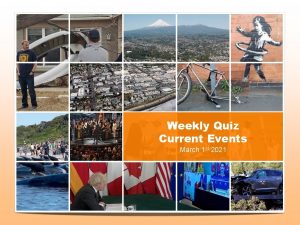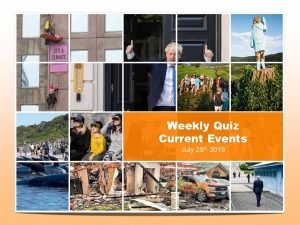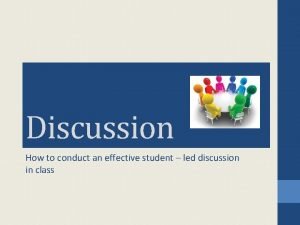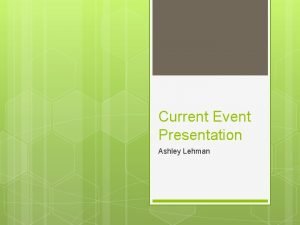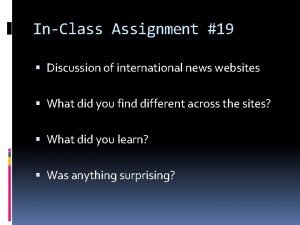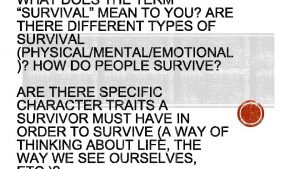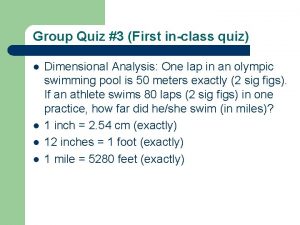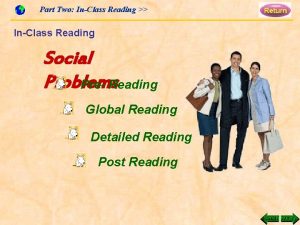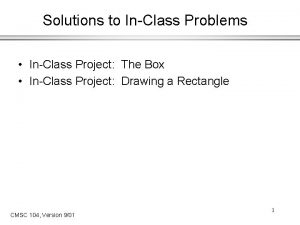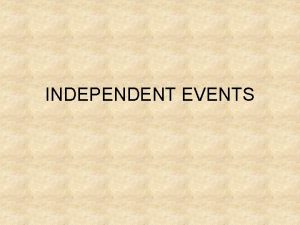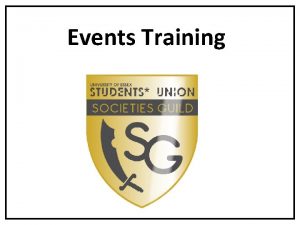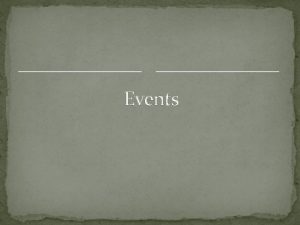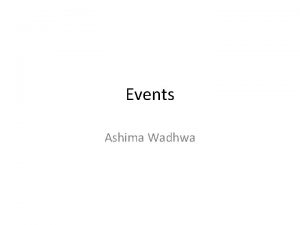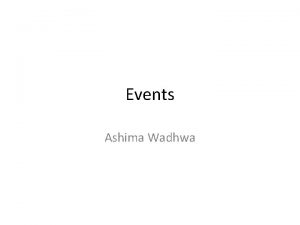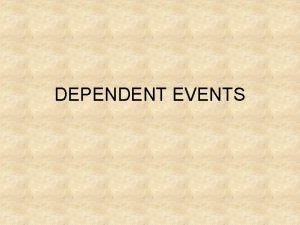InClass Assignment 5 Current Events Quiz InClass Discussion



















- Slides: 19

In-Class Assignment #5 • Current Events Quiz!

In-Class Discussion • As a class, let’s discuss your take on the audio vs. text stories. • Which did you enjoy more? • Which did you learn more from? • Which was more emotional?

Bennett Ch. 4: How Politicians Make the News Dr. Kristen Landreville Wed. 9/15 – Fri. 9/17

A Symbiotic Relationship Journalists Need Politicians Need Journalists • Appearances by government officials and agencies ▫ Nearly 75% of hard news • Inform journalists about current events • Dependency on press conferences, press releases, and official interviews ▫ Between 70%-90% of hard news • Why? • Keep journalists attuned to the public’s major concerns • Allow politicians to remain in full public view • Allow politicians to spread their influence and messages

How Politicians Use Media • Shaping public opinion via information control: 1. Withholding information 2. De-emphasis of information 3. Collection of information (or not) 4. Timing the release of information 5. Obfuscation of information 6. Symbolic events and press conferences

Getting Their Way • Politicians are more likely to be promoted and unchallenged by media when: 1. It’s early in their term. 2. The gravity of the issue or message is dire. 3. There is perceived elite and public support. • Cases in point: ▫ ▫ Afghanistan war Iraq war

It’s Like Scripted Reality TV • “A compelling story, even if factually inaccurate, can be more emotionally compelling than a dry recitation of the truth. ” – Frank Luntz, communication strategist. • When moving public opinion, remember: ▫ Simple, Emotional, Mass, Repetitive ▫ Avoid spontaneity, unplanned events, and vulnerable moments

Strategic Political Communication • Imagine you’re a political strategist hired by a candidate to build their image and make their message acceptable to the public. • This is your Plan of Action: 1. 2. 3. 4. 5. 6. 7. 8. Determine their political goals Understand their vulnerabilities Determine their audience Use polls and focus groups to understand audience Find language that makes candidate appealing Create media events to deliver message Keep candidate on message Distribute press releases and bombard media with message

The Art of Image Making • Psychological effects of symbols ▫ Cognitive ▫ Affective

The Art of Image Making • Successful politicians define the political situation. • Examples: • Civilian deaths vs. collateral damage or friendly fire • Freedom fighters vs. terrorists or insurgents • Taxes vs. fees or additional revenue • Flip-flopper vs. compromiser or bipartisan

How Can We Spin This?

Case Study on News Manufacturing and Image Making • “Global warming” vs. “climate change” ▫ ▫ Republicans look bad on environment Challenge science Creates conflict Plays to journalistic balance

The Impact of “Officialized” News and News Manufacturing • Public confusion about issues • Portrayals of grassroots groups or 3 rd parties as “crazy, radical ___” • Government inaction • Public acceptance of problems as “just a fact of life”

Bennett Ch. 4: How Politicians Make the News Dr. Kristen Landreville Wed. 9/15 – Fri. 9/17

Frontline: Karl Rove—The Architect An illustration of how politicians influence the news and the public

Strategic Political Communication • Imagine you’re a political strategist hired by a candidate to build their image and make their message acceptable to the public. • This is your Plan of Action: 1. 2. 3. 4. 5. 6. 7. 8. Determine their political goals Understand their vulnerabilities Determine their audience Use polls and focus groups to understand audience Find language that makes candidate appealing Create media events to deliver message Keep candidate on message Distribute press releases and bombard media with message

Frontline: Karl Rove—The Architect • 20 -minute clip • While viewing, consider these questions: 1. What were Rove’s behavior goals for the US? ▫ What did he want the public to do? 2. Who was Rove’s audience? ▫ Who were his messages for? 3. What were Rove’s messages? ▫ How did Rove create simple, emotional, mass, and repetitive messages?

Karl Rove—The Architect • http: //www. pbs. org/wgbh/pages/frontline/sho ws/architect/

In-Class Assignment #6 • Individually, answer the questions below. 1. What were Rove’s behavior goals for the US? ▫ What did he want the public to do? 2. Who was Rove’s audience? ▫ Who were his messages for? 3. What were Rove’s messages? ▫ How did Rove create simple, emotional, mass, and repetitive messages? 4. How does this clip illustrate how politicians influence the news and public? • In groups, discuss your answers. • As a class, discuss the answers and film.
 Current events quiz
Current events quiz What is the name
What is the name Fractional distillation
Fractional distillation Student-led discussion assignment
Student-led discussion assignment Mutually exclusive vs non mutually exclusive
Mutually exclusive vs non mutually exclusive Current events presentation
Current events presentation Middle ages jeopardy
Middle ages jeopardy Line currents
Line currents Power formula three phase
Power formula three phase Semiconductor
Semiconductor Ac systems lesson 4
Ac systems lesson 4 Drift vs diffusion current
Drift vs diffusion current Drift current and diffusion current in semiconductor
Drift current and diffusion current in semiconductor At cut off the jfet channel is
At cut off the jfet channel is In a ∆-connected source feeding a y-connected load
In a ∆-connected source feeding a y-connected load Holding current and latching current
Holding current and latching current Diffusion current formula
Diffusion current formula Why must the electrode holder be correctly sized?
Why must the electrode holder be correctly sized? Touch current vs leakage current
Touch current vs leakage current Kcl mesh analysis
Kcl mesh analysis
